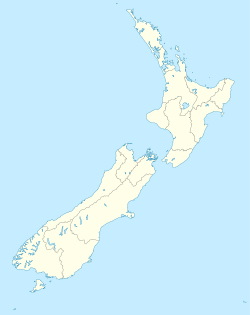- Mapua, New Zealand
-
Mapua Mapua's location within New Zealand Coordinates: 41°15′00″S 173°06′00″E / 41.25°S 173.1°ECoordinates: 41°15′00″S 173°06′00″E / 41.25°S 173.1°E Population (2006 [1]) - Total 1,878 Time zone NZST (UTC+12) - Summer (DST) NZDT (UTC+13) Area code 03 Mapua is a small town in the South Island of New Zealand.
It is to the west of Nelson on State Highway 60 and on the coastline of Tasman Bay. The 2006 census gave a population of 1878, up 16.1 percent since the 2001 Census.[2]:
With a thriving wharf and commercial area, Mapua has grown in popularity for visitors, with numbers swelling the region over the summer months.
A large fair and market is held every Easter Sunday. Up to 30,000 people visit the town on this day to enjoy rides, stalls, and other attractions. The local schools and playcentre benefit from the fair, which is their primary fundraising activity.
History
Middens, tools and human bones found at Grossis Point suggest a Maori settlement was located here during the archaic period (900AD - 1450AD). The lack of weapons and evidence of cannibal feasts however show that the Maori living in this district were peaceful and seldom were involved in wars. By the 1820's, Maori from the North Island (led by the Maori Chief Te Rauparaha) came to the South Island with warriors armed with Muskets, and took over Marlborough before sending half his army over to take over Tasman Bay and Golden Bay. Due to the considerable advantage in weaponry and skill, the local Maori populations were soon overcome. After the battle, most of the invaders moved on leaving only a small local population of Maori left in the region. The first land in Mapua was bought in 1854 by Captain James S. Cross which was 166 acres, only costing him 60 pounds.
The first resident of Mapua was James Heatly who was a local fisherman. As well as fishing, he hunted rabbits which he brought to Nelson to sell. The port area was originally known as the Western Entrance, and the township known as Seaton Township (by a surveyor who had been subdividing part of the town). Mr F.I. Ledger helped plan out the town and later named it 'Mapua' which was also what the New Zealand telephone guide named it. Mapua means 'abundance' or 'prolific' when interpreted into English. By 1915, the wharf because substantial and was able to cope with larger ships coming into the harbour for the apple trade, which was booming at this time. The poor roads in the area meant that shipping the apples out was the only option, however eventually a road was built around the Ruby Bay bluffs, joining up Nelson and Motueka. A shop was first opened in 1921 to service the locals, and was built on the same plot of land the present day shop is on now [3]
Former contaminated site
In the 20th century, Mapua was one of the most contaminated sites in New Zealand due to pesticide residues in the soils from a now defunct factory, but has since had a major cleanup operation.
In 1932 the Fruitgrowers Chemical Company built a plant to manufacture pesticides for use in the numerous orchards in the surrounding area. In the 1940s organomercury and organochlorine pesticides, including DDT, DDD, dieldrin, 2,4-D and paraquat, were produced. Organophosphorous pesticides were produced from the 1960s. By 1978, 124 chemicals were being used to produce 84 different formulations. The plant closed in 1988.
The site was taken over by the Tasman District Council in 1989, and measures were taken to prevent leaching of the chemicals into the adjoining Waimea Inlet. The 1999 Budget allocated $3.7 million towards containment of the site. Site decontamination was carried out, initially by Thiess Pty. Ltd. but later by the Ministry for the Environment. The site was handed back to the Tasman District Council in November 2007.[4]
References
- ^ Statistics New Zealand. "Quick stats about Mapua". stats.govt.nz. http://www.stats.govt.nz/Census/2006CensusHomePage/QuickStats/AboutAPlace/SnapShot.aspx?tab=Families&id=3581825&p=y&printall=true&map=off. Retrieved 9 November 2010.
- ^ Quickstats about Mapua
- ^ "MAPUA - A Brief History". mapua.gen.nz. http://www.mapua.gen.nz/history.html. Retrieved 9 November 2010.
- ^ Parliamentary Commissioner for the Environment (July 2008). Investigation into the remediation of the contaminated site at Mapua. PCE. ISBN 978-1-877274-17-6 (print) ISBN 978-1-877274-18-3 (electronic). http://pce.govt.nz/reports/allreports/investigation_into_the_remediation.shtml.
Categories:- Populated places in New Zealand
- Nelson and Tasman Region geography stubs
Wikimedia Foundation. 2010.


